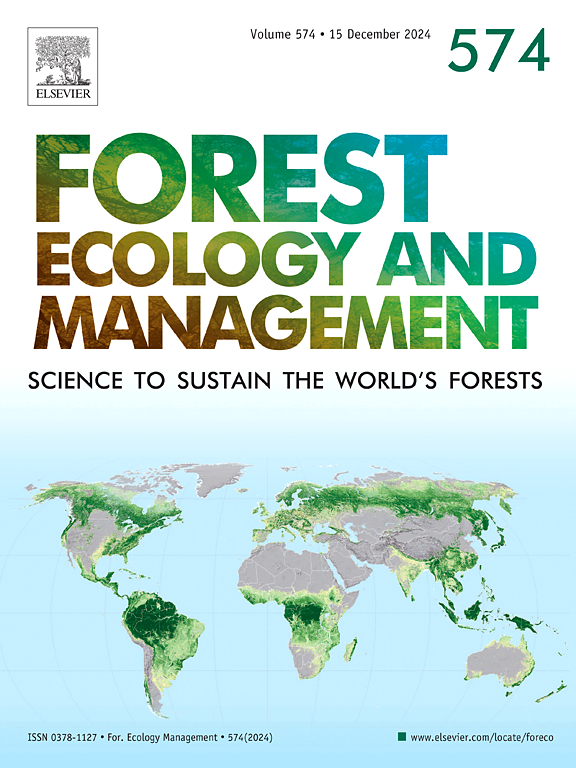Ash dieback: A single-species catastrophe or a cascade of ecological effects in the ground flora?
IF 3.7
2区 农林科学
Q1 FORESTRY
引用次数: 0
Abstract
Climate change and human activities have accelerated the spread of non-native species, including forest pests and pathogens, significantly contributing to global biodiversity loss. Pathogens pose a significant threat to forest ecosystems due to a lack of coevolution with native hosts, resulting in ineffective defence mechanisms and severe consequences for the affected tree species. Ash dieback, caused by the fungus Hymenoscyphus fraxineus, is a relatively new invasive forest pathogen threatening ash (Fraxinus excelsior) with mortality rates in northern Europe reaching up to 80 %. The loss of ash due to dieback has severe ecological implications, potentially leading to an extinction cascade as ash provides crucial habitats and resources for many organisms. Despite this, the consequences of ash dieback on associated communities are largely unknown. To address this, we analysed changes in species richness, vegetation structure, and composition in 82 permanent vegetation plots across 23 Norwegian woodlands. We compared data collected before and 10–14 years after the emergence of ash dieback. In these woodlands, ash significantly declined in cover, leading to changes in tree species composition and facilitating the establishment of other woody tree species like hazel (Corylus avellana) and the invasive species sycamore (Acer pseudoplatanus). Despite these changes in the tree species composition, no significant alterations were observed in the understory plant community, indicating a degree of ecosystem resilience or a lagging community response. At this point, and with our focus on the vascular plants, we do not find support for cascading effects due to ash dieback. However, our findings demonstrate that one invasive species is facilitating the expansion of another, raising concerns about potential ecological imbalance and cascading effects in the future.
白蜡树枯死:是单一物种的灾难,还是地面植物区系生态效应的连环效应?
气候变化和人类活动加速了包括森林害虫和病原体在内的非本地物种的传播,大大加剧了全球生物多样性的丧失。病原体对森林生态系统构成重大威胁,因为它们缺乏与本地宿主的共同进化,导致防御机制失效,给受影响的树种带来严重后果。白蜡树枯死病是由白蜡树真菌(Hymenoscyphus fraxineus)引起的,是一种相对较新的入侵性森林病原体,威胁着白蜡树(Fraxinus excelsior),在北欧的死亡率高达 80%。白蜡树枯死造成的损失会对生态产生严重影响,有可能导致一连串的物种灭绝,因为白蜡树为许多生物提供了重要的栖息地和资源。尽管如此,白蜡树枯死对相关群落造成的后果在很大程度上还是未知数。为了解决这个问题,我们分析了挪威23个林地中82个永久性植被地块的物种丰富度、植被结构和组成的变化。我们比较了白蜡枯死前和枯死后 10-14 年收集的数据。在这些林地中,白蜡树的覆盖率明显下降,导致树种组成发生变化,并促进了榛树(Corylus avellana)和入侵树种梧桐(Acer pseudoplatanus)等其他木本树种的生长。尽管树种组成发生了这些变化,但在林下植物群落中没有观察到明显的变化,这表明生态系统具有一定程度的恢复力或群落反应滞后。在这一点上,由于我们的重点是维管束植物,我们没有发现白蜡树枯死造成的级联效应。不过,我们的研究结果表明,一种入侵物种正在促进另一种入侵物种的扩张,这引起了人们对未来可能出现的生态失衡和连带效应的担忧。
本文章由计算机程序翻译,如有差异,请以英文原文为准。
求助全文
约1分钟内获得全文
求助全文
来源期刊

Forest Ecology and Management
农林科学-林学
CiteScore
7.50
自引率
10.80%
发文量
665
审稿时长
39 days
期刊介绍:
Forest Ecology and Management publishes scientific articles linking forest ecology with forest management, focusing on the application of biological, ecological and social knowledge to the management and conservation of plantations and natural forests. The scope of the journal includes all forest ecosystems of the world.
A peer-review process ensures the quality and international interest of the manuscripts accepted for publication. The journal encourages communication between scientists in disparate fields who share a common interest in ecology and forest management, bridging the gap between research workers and forest managers.
We encourage submission of papers that will have the strongest interest and value to the Journal''s international readership. Some key features of papers with strong interest include:
1. Clear connections between the ecology and management of forests;
2. Novel ideas or approaches to important challenges in forest ecology and management;
3. Studies that address a population of interest beyond the scale of single research sites, Three key points in the design of forest experiments, Forest Ecology and Management 255 (2008) 2022-2023);
4. Review Articles on timely, important topics. Authors are welcome to contact one of the editors to discuss the suitability of a potential review manuscript.
The Journal encourages proposals for special issues examining important areas of forest ecology and management. Potential guest editors should contact any of the Editors to begin discussions about topics, potential papers, and other details.
 求助内容:
求助内容: 应助结果提醒方式:
应助结果提醒方式:


